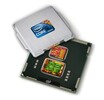Intel Core i5-460M vs AMD Ryzen 5 3550H vs AMD Ryzen 5 3500U
Intel Core i5-460M
► remove from comparison
The Intel Core i5-460M is a high end dual core CPU for laptops and clocks (due to the Turbo Mode) from 2.53 to 2.8 GHz. Each core is based on the Nehalem (Westmere) micro-architecture. Hyperthreading enables the Dual Core CPU to handle 4 threads at once (for a better usage of the pipeline). Compared to the Core i5-540M, the 460M does not support AES, VT-d and Trusted Execution functions and features a slower Turbo Boost (2.8 versus 3.06 GHz).
A feature of the new Core i5-460M is the integrated graphics card called GMA HD and memory controller. Both are on a separate die that is still manufactured in 45nm whereas the CPU die is already manufactured in the new 32nm process.
The performance of the Core i5-460M is on average faster than a 2.8 GHz Core 2 Duo T9800 and in some benchmarks even faster than the fastest Core 2 Duo T9900 (e.g. 3DMark 06 CPU Score). Therefore, the Core i5-460M is a high end dual core cpu which should handle all daily work and gaming tasks. Only the quad core i7 CPUs can be noticeably faster at tasks that require four or more threads (e.g. rendering).
The integrated Intel Graphics Media Accelerator HD (GMA HD) graphics card is known to be clocked up to 500-766 MHz and should be clearly faster than the old GMA 4500MHD. A GeForce 9400M (ION) should still be a faster (especially as Nvidia and ATI cards have a better driver support than Intel up to now). According to rumors, the GMA core will also use the Turbo Mode regulate the clock speed.
The power consumption of 35 Watt TDP (max.) counts for the whole package and therefore it is clearly better than the 35 Watt TDP of the Core 2 Duo T-series (CPU alone). Due to the Turbo Boost, the Core i5 is likely to use the whole TDP of 35 Watt under load and therefore can use more power than a similar specified Core 2 Duo. In Idle mode, the i5 uses clearly less power than the Core 2 Duo CPUs.
AMD Ryzen 5 3550H
► remove from comparison
The AMD Ryzen 5 3550H is a mobile SoC that was announced in January 2019. It combines four Zen+ cores (8 threads) clocked at 2.1 GHz to 3.7 GHz with a Radeon RX Vega 8 graphics adapter with 8 CUs (512 Shaders) clocked at up to 1,200 MHz. Compared to the similar Ryzen 5 3500U, the 3550H offers a 20 Watt higher TDP and therefore a better performance under long periods of load. The integrated dual-channel memory controller supports up to DDR4-2400 memory. As the features of the Picasso APUs are the same compared to the Raven Ridge predecessors, we point to our Raven Ridge launch article.
The Picasso SoCs use the Zen+ microarchitecture with slight improvements that should lead to a 3% IPS (performance per clock) improvements. Furthermore, the 12 nm process allows higher clock rates at similar power consumptions.
Performance
The average 3550H in our database proves to be a solid mid-range CPU, its multi-thread benchmark scores hovering close to those of the Intel Core i7-10710U and the Core i5-8257U. Which is a little slow for an H-class processor, as of late 2021, but still more than enough for the vast majority of apps and games, provided one is fine with having to wait a little longer than usual for that 4K video encoding job to get completed.
Thanks to its decent cooling solution and sufficiently high CPU power limits, the Pavilion Gaming 15-ec0002ng is among the fastest laptops powered by the 3550H that we know of. It can be more than 20% faster in CPU-bound workloads than the slowest system featuring the same chip in our database, as of August 2023.
Power consumption
This Ryzen 5 series chip has a default TDP (also known as the long-term power limit) of 35 W. Laptop makers are free to reduce that value significantly with 12 W being the minimum AMD-recommended value. Clock speeds and performance would take a hit as a result; either way, that's a little too high to allow for passively cooled designs.
Last but not the least, the AMD Ryzen 5 3550H is built with a 12 nm process for lower-than-average, as of mid 2023, energy efficiency.
AMD Ryzen 5 3500U
► remove from comparison
The AMD Ryzen 5 3500U is a mobile SoC that was announced in January 2019. It combines four Zen+ cores (8 threads) clocked at 2.1 GHz to 3.7 GHz with a Radeon RX Vega 8 iGPU with 8 CUs (512 Shaders) clocked at up to 1200 MHz. Specified at 15 Watt TDP, the SoC is intended for thin mid-range laptops. In Chromebooks, AMD calles the APU AMD Ryzen 5 3500C, but the specifications (and performance) are the same.
The Picasso SoC uses the Zen+ microarchitecture with slight improvements that should lead to a 3% IPS (performance per clock) improvements. Furthermore, the 12 nm process allows for higher clocks at similar power consumption.
The integrated dual-channel memory controller supports up to DDR4-2400 memory. As the features of the Picasso APUs are the same compared to the Raven Ridge predecessors, we point to our Raven Ridge launch article.
Performance
The average 3500U in our database matches the Intel Core i7-1065G7 in multi-thread performance to be an OK lower mid-range option, as of early 2021.
The Honor MagicBook 14 is among the fastest laptops powered by the 3500U that we know of. It can be up to 50% faster in CPU-bound workloads than the slowest system featuring the same chip in our database, as of August 2023.
Power consumption
This Ryzen 5 series chip has a default TDP (also known as the long-term power limit) of 15 W, a value that laptop makers are free to set to anything between 12 W and 35 W with clock speeds and performance changing accordingly as a result. Either way, this is a tad too high to allow for passively cooled designs.
The chip is manufactured on a 12 nm process for subpar, as of late 2022, energy efficiency.
| Model | Intel Core i5-460M | AMD Ryzen 5 3550H | AMD Ryzen 5 3500U | ||||||||||||||||||||||||||||||||||||||||||||||||||||||||||||||||||||||||||||||||||||||||||||||||||||
| Codename | Arrandale | Picasso-U (Zen+) | Picasso-U (Zen+) | ||||||||||||||||||||||||||||||||||||||||||||||||||||||||||||||||||||||||||||||||||||||||||||||||||||
| Series | Intel Core i5 | AMD Picasso (Ryzen 3000 APU) | AMD Picasso (Ryzen 3000 APU) | ||||||||||||||||||||||||||||||||||||||||||||||||||||||||||||||||||||||||||||||||||||||||||||||||||||
| Series: Picasso (Ryzen 3000 APU) Picasso-U (Zen+) |
|
|
| ||||||||||||||||||||||||||||||||||||||||||||||||||||||||||||||||||||||||||||||||||||||||||||||||||||
| Clock | 2530 - 2800 MHz | 2100 - 3700 MHz | 2100 - 3700 MHz | ||||||||||||||||||||||||||||||||||||||||||||||||||||||||||||||||||||||||||||||||||||||||||||||||||||
| FSB | 2400 | ||||||||||||||||||||||||||||||||||||||||||||||||||||||||||||||||||||||||||||||||||||||||||||||||||||||
| L1 Cache | 128 KB | 384 KB | 384 KB | ||||||||||||||||||||||||||||||||||||||||||||||||||||||||||||||||||||||||||||||||||||||||||||||||||||
| L2 Cache | 512 KB | 2 MB | 2 MB | ||||||||||||||||||||||||||||||||||||||||||||||||||||||||||||||||||||||||||||||||||||||||||||||||||||
| L3 Cache | 3 MB | 4 MB | 4 MB | ||||||||||||||||||||||||||||||||||||||||||||||||||||||||||||||||||||||||||||||||||||||||||||||||||||
| Cores / Threads | 2 / 4 | 4 / 8 | 4 / 8 | ||||||||||||||||||||||||||||||||||||||||||||||||||||||||||||||||||||||||||||||||||||||||||||||||||||
| TDP | 35 Watt | 35 Watt | 15 Watt | ||||||||||||||||||||||||||||||||||||||||||||||||||||||||||||||||||||||||||||||||||||||||||||||||||||
| Transistors | 382+177 Million | 4500 Million | 4500 Million | ||||||||||||||||||||||||||||||||||||||||||||||||||||||||||||||||||||||||||||||||||||||||||||||||||||
| Technology | 32 nm | 12 nm | 12 nm | ||||||||||||||||||||||||||||||||||||||||||||||||||||||||||||||||||||||||||||||||||||||||||||||||||||
| Die Size | 81+114 mm2 | ||||||||||||||||||||||||||||||||||||||||||||||||||||||||||||||||||||||||||||||||||||||||||||||||||||||
| max. Temp. | 105 °C | 105 °C | 105 °C | ||||||||||||||||||||||||||||||||||||||||||||||||||||||||||||||||||||||||||||||||||||||||||||||||||||
| Socket | BGA1288, PGA988 | FP5 | FP5 | ||||||||||||||||||||||||||||||||||||||||||||||||||||||||||||||||||||||||||||||||||||||||||||||||||||
| Features | integrated DDR3 memory controller, GMA HD Graphics, MMX, SSE (1,2,3,3S, 4.1, 3.2), EM64T, VT-x | DDR4-2400 RAM, PCIe 3, MMX (+), SSE, SSE2, SSE3, SSSE3, SSE4.1, SSE4.2, SSE4A, AES, AVX, AVX2, FMA3, SHA | DDR4-2400 RAM, PCIe 3, MMX, SSE, SSE2, SSE3, SSSE3, SSE4A, SSE4.1, SSE4.2, AVX, AVX2, BMI2, ABM, FMA, ADX, SMEP, SMAP, SMT, CPB, AES-NI, RDRAND, RDSEED, SHA, SME | ||||||||||||||||||||||||||||||||||||||||||||||||||||||||||||||||||||||||||||||||||||||||||||||||||||
| Architecture | x86 | x86 | x86 | ||||||||||||||||||||||||||||||||||||||||||||||||||||||||||||||||||||||||||||||||||||||||||||||||||||
| Announced | |||||||||||||||||||||||||||||||||||||||||||||||||||||||||||||||||||||||||||||||||||||||||||||||||||||||
| Manufacturer | ark.intel.com | www.amd.com | www.amd.com | ||||||||||||||||||||||||||||||||||||||||||||||||||||||||||||||||||||||||||||||||||||||||||||||||||||
| iGPU | AMD Radeon RX Vega 8 (Ryzen 2000/3000) ( - 1200 MHz) | AMD Radeon RX Vega 8 (Ryzen 2000/3000) ( - 1200 MHz) |
Benchmarks
Average Benchmarks Intel Core i5-460M → 100% n=11
Average Benchmarks AMD Ryzen 5 3550H → 230% n=11
Average Benchmarks AMD Ryzen 5 3500U → 191% n=11
* Smaller numbers mean a higher performance
1 This benchmark is not used for the average calculation













